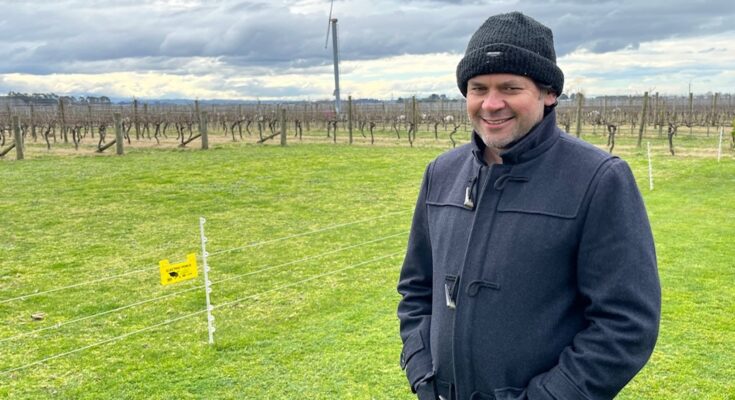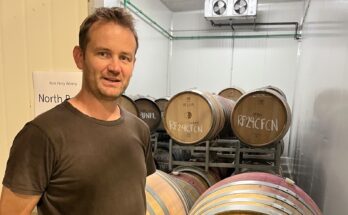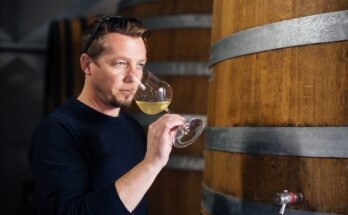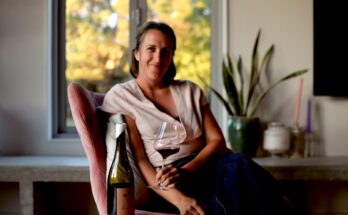I start my chat with Barry Riwai talking about trips to Hawke’s Bay. I try to come down at least once a year, but no matter how many times I visit there always seems to be more things to do. It’s not just the new things – or people doing something different, but I also haven’t been to all of the legendary places yet. For example, I haven’t been up De la Terre yet, and I only just visited Te Mata last time I was down… I’m seeing Cairn at Askerne, Amy at Amoise and Julianne at Collaboration this trip, I hope.
Barry: Ah, well I’d describe all those people as good friends! And you’re working at the Vic Road Wine Bar & Cellar in Devonport aren’t you? I can’t remember the names of the owners, but we had at least two bottle of wine at the end of that Dinner we had at the restaurant. It was a great evening – the food was incredible! It was my first night of four nights in a row, but it was fun.
WineFolio: Yes, we try to make it fun. We had Ian and Linda Quinn from Two Terraces in last night – literally, and I was presenting it. We had everyone in stitches. It was also good to hear from people who don’t make wine – so just the grape-growing side of it. It was quite different for everybody who comes along. We showed two Chenin, two Chardonnay and two Gamay – wines made from their Two Terraces vineyard. And there wasn’t as much focus on the wines – describing them and so on.
BR: When winemakers deliver a tasting note it just sends people to sleep.
WF: We had Kate Radburnd up for a Tasting evening, and it was the first time she had been up from the Bay since everything that happened in the cyclone. And it was quite an emotional night. She talks well about ‘the place’. It’s what I base my whole site upon – if you can get people to discover the place, then they’ll start to understand the wine in the glass better.
BR: We are small family-owned. You met Beatrix, who’s third generation of the Ham family. Paul is her Father and they live in the house just there. He is one of three sons, and their parents Antonius and Leonarda – originally Dutch, but moved here in the 60’s. They have a plant nursery business in Manawatu, and were all members of the Manawatu Wine Society. They thought as a little project they’d start a vineyard somewhere – and chose this bit of land as Hawke’s Bay isn’t too hard to get to from Palmerston North. In the late 80’s Marlborough was only just starting.
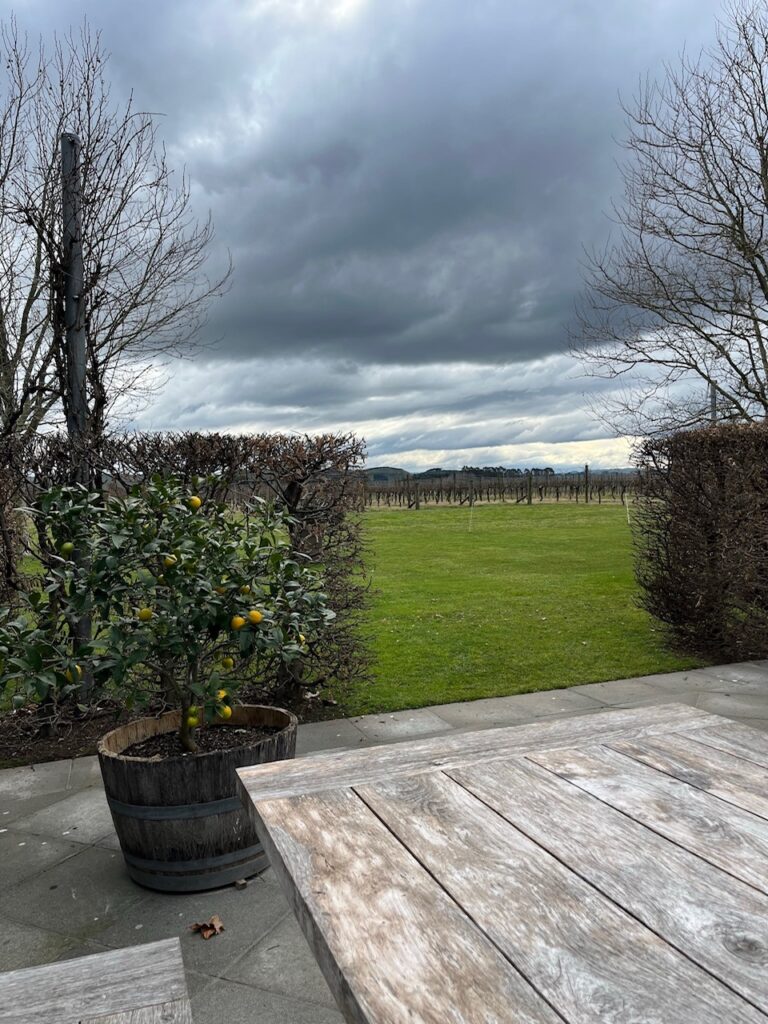
And because they were into Cabernet! There was only really Ngatarawa at that stage in Bridge Pa, who had 40 hectares. They planed 20 hectares here, which is roughly a square; and another 10 hectares down the road where Antonius and Leonarda lived. So at that stage they’d doubled the plantings in Bridge Pa. They really were pioneers. Today there’s between 800 and 900 hectares planted in Bridge Pa. And that’s down to the red soils underneath our feet.
First names – Antonius, Leonarda, Paul, Henry and Anthony, the three brothers in descending order is where Alpha comes from – and ‘Domus’ means home. I don’t think it was planned, but that’s where the name came from. The planes on the labels are because the aerodrome is just down the road here; and they’ve always had a Tiger Moth on the labels.
The vineyard property was separated off from the main homestead and sold off, but Paul and Katherine have since bought the adjoining six hectares, so we’ve got the homestead back, and six hectares of land to plant! We’ve got vines ordered. More and more Chardonnay.
Our soils are quite uniform, but the soils at the front, closer to the road are deeper – we’ve got more of it. And a little pocket with some clay in it – the rest doesn’t have any clay, just beautiful silty stuff. They’ve all washed down from the hills up there. The river last flowed through here 10,000 years ago – except in floods! We were lucky in the recent floods that we didn’t get anything at all. We lost power at home but that was it. The vineyard was fine. But even so it was just harrowing. No power, no internet, no phones.
WF: In Auckland we had quite bad floods, where a few people died. But the whole of Auckland – in particular where properties were quite badly affected – now, every time we have a storm with heavy rain, it triggers a response in people. And it is like COVID times. Everyone rushes home, panic buys toilet paper, and hugs their loved ones. It’s the same emotional response and feeling.
BR: We’ve had three wet years on the trot, and it they have been quite difficult seasons. We have been converting to BioGro over those three years. 2023 was our first fully organic year, which wasn’t necessarily the best timing in the world. But we got through it. We have to make sure that the vines are really well trained, so we don’t set the vines up to fail. We do a whole heap more hand-work, which in the end, saved us. Because we did lots of leaf plucking and shoot positioning, the bunches were out in the sun. They got wet, for sure, but the sun dried them.
It was February 20th and we had plans to pick the whole lot. It was looking good but we were so worried, because in the two weeks after the Cyclone we had another 100mms of rain, on top of the 400. We made so many plans for vintage, but in the end the last plan – was just the normal plan. We got to the point where we just carried on as normal, and we were really lucky.
WF: It’s good that after all that, some normality was restored. Do you do lots of different picks to get a balance?
BR: We managed to hang some Chardonnay out until April. It was the cleanest block and we just thought we’d chance our hand. We have five different blocks of Chardonnay for table wine and a couple of blocks for bubbles as well. We did juggle a couple around. A couple of early ones I did keep for table wine. The young ones at the driveway there – Clone 95. There was five weeks between that pick and the last pick. All the clones ripen slightly differently. Some you want to push slightly higher brix because you get better flavour and lower acid. Some you want to pick early – it’s all by taste. Wines that we’ve made recently tend to be on the leaner side, so we’re just trying to push a bit bigger.
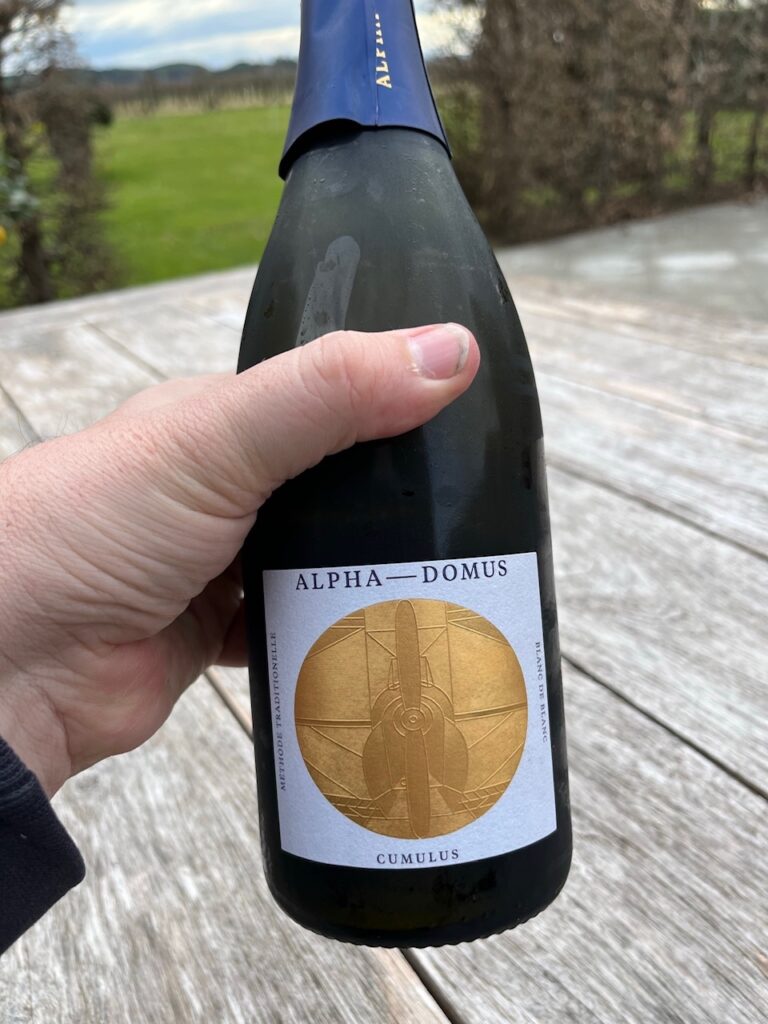
WF: More Chardonnay is what we want!
BR: Our newest block will be Chardonnay and we’re planting a little bit more Syrah. The six hectares will be Chardonnay, mostly for bubbles. Clone 6 is our bubbles clone, but we are planting a few more clones that are a bit more multi-purpose. Normally, the more bubbles we make, the better our table wines are. We’re probably one of the few people in the country planting Clone 6. Even so, there was a two-year lead-in time to get it.
WF: Tell me about how you ended up making wine here?
BR: I grew up in Hamilton, and got out of there as quickly as I could. I went on an exchange in my last year of school and was in South America. Then went to Waikato University doing Spanish and Political Science. Had a very social first year! So re-evaluated at the end of my social year. Discovered that I quite liked drinking, and I’ve always liked wine. Saw an advert for EIT in the local newspaper, and got accepted for that. Came to Hawke’s Bay in 1997 and I haven’t left.
That, in your glass is our Cumulus – we’ve been making since about 2000. When I got here we wanted to ramp up the production and make a bit more – introduce it to trade. Ever since it has been growing steadily. Bone dry, but, being Hawke’s Bay the acids aren’t that great – not enormous like in Champagne, so we don’t need Dosage.
WF: That’s actually terrific. I’m quite taken aback by how good that is – for a wine I’ve never had before. That’s so clean and zesty and with a lovely mousse to the bubbles.
BR: When the production was smaller it was all done here – I used to do the riddling myself, but it grew too big. We used to have it under a crown seal as well, but wanted to go to a more traditional look – restaurants were asking for that, so we have it disgorged at Soljans. The variant for us is the Cook Strait – that would add three or four dollars per bottle, just in freight, to use No.1 as our partner.
WF: But Soljans are great – they’re old school.
BR: They are! Tony Soljan – I love him. I went to see him a year ago and we actually tasted every single wine in the building, and he sent me away with a couple of bottles as well. Lovely people.
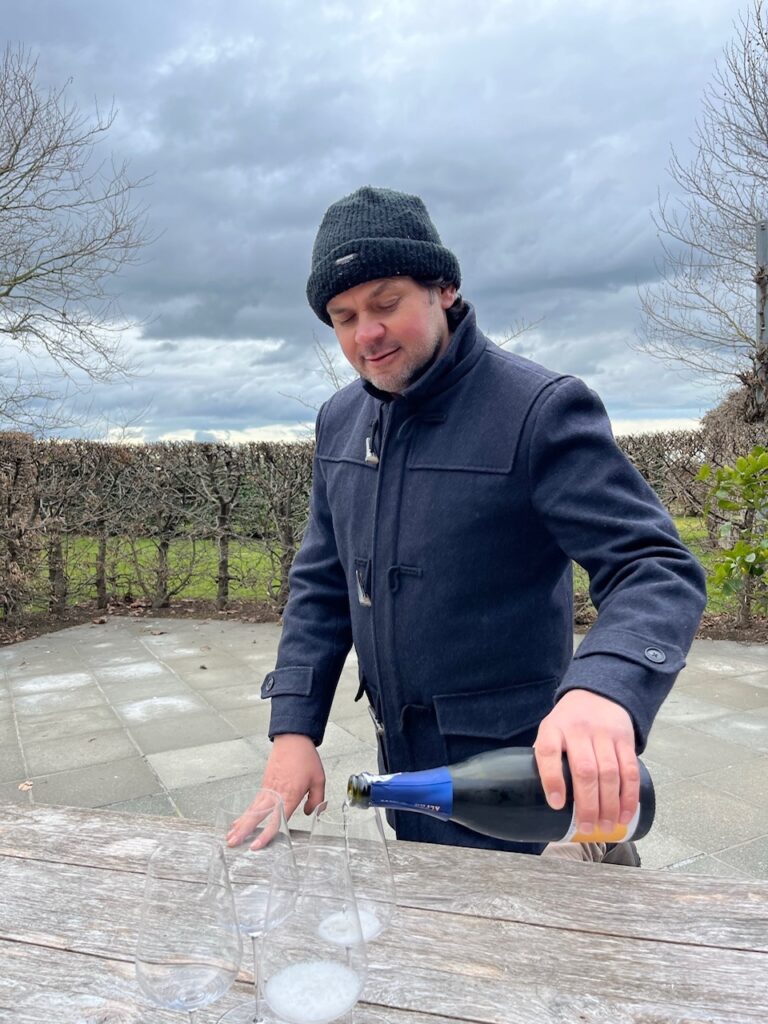
WF: Do you think people taste bubbles? You can pay quite a bit for sparkling wines now, but I do wonder if people can identify between the various types, or styles?
BR: For me, Bollinger, when I can get it – and I certainly taste that! When you spend a bit of money you can taste the difference.
We are joined by Managing Director Paul Ham and Barry hurries up to tell me more of the history…
BR: When the vineyard was planted – that there was Pinot Noir, and they had a heap of Sauvignon Blanc. And then Marlborough came along and Sem/Sav wasn’t popular any more. Then Central Otago started and suddenly Hawke’s Bay Pinot wasn’t a thing. Was the Sauvignon the first to go? Because we didn’t have Syrah at all back then. The Pinot was good, but that got pulled out.
WF: So do we think Chardonnay or Syrah is the great shining light for the future? Or is it both? I think it is Syrah, because Hawke’s Bay makes great Chardonnay but..
BR: No-one makes Syrah that tastes like we make.
WF: Yes. And like a Cote Rotie, or a Barossa Shiraz – you can tell where it is from. Even a great Hawke’s Bay Chardonnay – you try it and you’re like “well that is magnificent, but do I know it’s from Hawke’s Bay?”
BR: I agree with you. And I think that Syrah will leapfrog it more, slowly. Chardonnay will be the white wine from Hawke’s Bay, and Syrah will be 80% of the red. There’ll still be Merlot and Cabernets. Because when Cabernet is good, it’s great.
WF: Well Merlot in a great year is fantastic.
BR: The thing is with the Merlot/Cabernets in a great year – they taste like they could be good Bordeaux. Whereas the Syrah in a great year tastes like it’s from here.
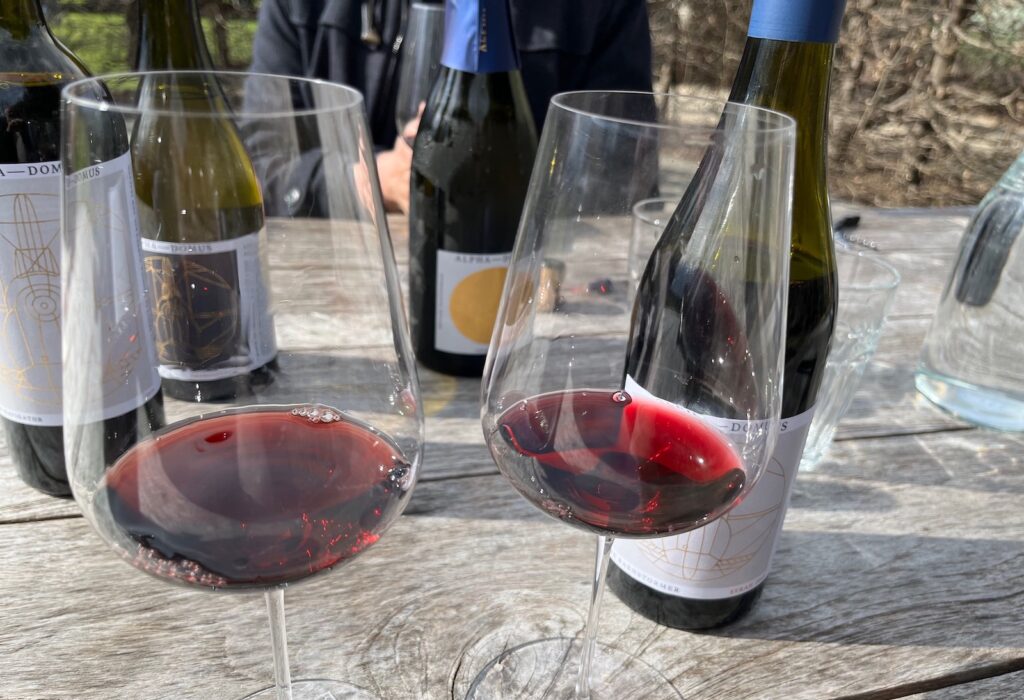
Paul Ham: The question I have though is ‘do you like it?’ Syrah from Hawke’s Bay. Because it is alright saying it’s unique – but do you like it?
WF: I do try and steer away from that sort of question as much as I can. Because although the WineFolio website is just me really, and the reviews are all just my opinions alone – I don’t want everything I do to be an opinion piece. I try very hard to be objective in terms of looking holistically at the world of wine. So I don’t simple focus on what I prefer – I want to cover every aspect, and style. That might include wine like Rosé that I wouldn’t naturally choose.
PH: I guess my question was around less of what you personally like. Let me put it another way – do you think this style will get traction because it will be appealing to the consumer?
BR: We need to know because we’ve got vineyards to plant and it’s a ten year program.
WF: Hmmm. I would answer that with another question, which I think sheds some light on it. Why does someone in the USA like New Zealand Pinot Noir? Is it because it has some novelty value that a tiny country at the end of the world makes Pinot that is quite good? Presumably they have access to a diverse range of styles, prices from across the world. I’d hope that it is a genuine affection for what’s in the glass alone, and not an also/add-on to their love of our Sauvignon Blanc? Are our wines good enough to really stand out against a world of competition? I don’t have that answer. Certainly the style of many Hawke’s Bay Syrah has a lightness and beauty that you won’t see much of in other places.
BR: This is our top Chardonnay. We like Chardonnay that’s flavoursome. It’s about 50% new oak, but there’s enough fruit there to handle that. People will say “have you got a buttery one?” but I really don’t like those – and I don’t think people generally do either – even if they somehow think they do! Full bodied and full-flavoured but not overdone in any aspect. It has lower acidity than usual, but people are loving it, so I’m thinking ‘is this where we should be?’ I hope it reflects the vineyards and the season too. It was a longer season, a warmer season with quite low crops.
Until recently we only had the one clone of Syrah – Mass Selection, which is what everyone has. Our four different blocks of Mass Selection are all different! I’m not sure if it’s a vine age thing, or source block thing. They’re not incredibly different but you’d never say they were exactly the same. We are noticing that Syrah is probably the vine that’s changed the most with organics. Syrah is a weed. It’s the most vigorous grape variety, in New Zealand at least. Even on our dry soils they grow like crazy. Having grass underneath has really changed them. We’re getting smaller bunches of smaller berries.
We’re also changing the way we prune. Previously in some years we’d literally put half the crop on the ground. You’d look down the rows and it would be black, with fruit. Now, we’re hitting our tonnage targets right from the beginning, so we don’t have to do the labour of the thinning. We think that of all the Bridge Pa Syrahs, we are the lightest and finest.
WF: Can we talk about that? Lighter and finer. Is there a reason for that? Is that something you’re aiming for, or is that what nature gives you?
BR: It’s what the vineyard does. If we wanted to make it bigger and bolder, it wouldn’t work. The Villa wines went from dark, inky jammy things to lighter and finer, from Gimblett. The same history from Craggy – they went from making Port to making to something that’s really floral and pretty. Syrah can be like that, you just have to let it be. We choose to let it be. You could hang it out for an extra five weeks and get a bit more colour and flavour, but have you missed the little special point? I think a lot of people just push it too far.
WF: And the winemaking. People stopping doing things to it. Syrah seemed to be one of things that people seemed to think they had to work it more.
BR: Not poking the death out of it. Well, people thought we had to make Barossa, and we don’t. To me – this tastes of the vineyard, here.
WF: I get asked a lot what I think of the New Zealand wine industry and one of the phrases is ‘its coming-of-age’. The easy answer to that is ‘vine age’. And whilst that will have something to do with it, I’d add ‘winemaker age’ to that list. People learning… and learning what not to do.
BR: You don’t have to do everything. Particularly with moving into organics, and having to look at everything that you do, or add. In so many ways it is easier not to add anything. We’re making better wines. What’s in the glass is essentially grape juice, with a little bit of oak, and we still use sulphur dioxide. With organics, a bit less now. Knowing what not to do is the key. In a season like the one just passed – you use the tools because you have to make decent wine. If you start with good fruit, it’s really easy.
With this Syrah we don’t do too much. It’s a quick, hot ferment and we leave them for about a month on skins. Not a heap of pumping over – caps get wet about once a week. They just build body and get more interesting. They move past being fruity and angular, and get more layers of flavour. It goes into mostly seasoned oak and we’ve started using puncheons. Treating it more like Chardonnay. There are a lot of similarities in the winemaking.
We do have three tiers – from ‘Special Reserve’ down to Collection which is on-premise. People won’t see these wines at a supermarket – unless it’s a good supermarket, like a New World with a Fine Wine section. We tell people it is single vineyard, from one place – family owned.
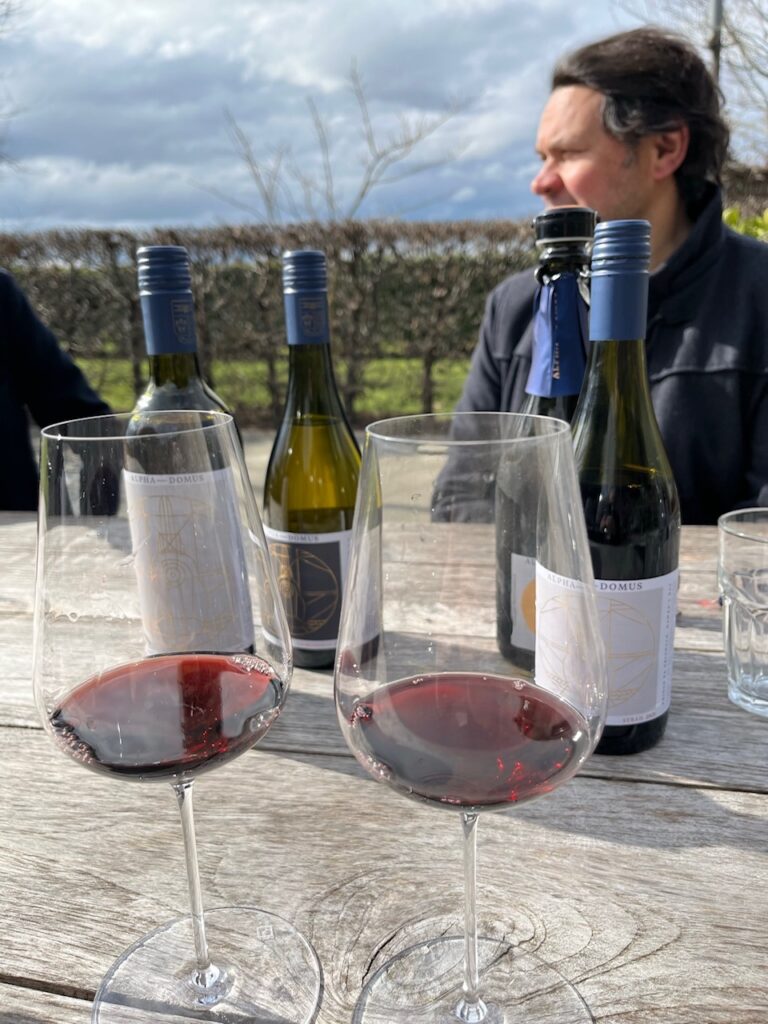
WF: The Syrah isn’t a typical example, but it has everything in there that a discerning consumer would like. It’s got a ‘modern’ feel to it. It’s not Grandad’s wine. It is very fresh and would have appeal to a younger demographic – it feels lighter, new and energetic. A joyful, exhuberant glass of wine. It is a cooler vintage isn’t it? – which I think shows. Not in this, obviously, but do you do any whole bunch?
BR: We have in the past – just a couple of tonnes here and there. 2021 wasn’t a vintage to play. The picking window was very narrow and you had to be onto it. That glass of wine smells like the grapes that I remember, when they were on their skins.
WF: How are the older vintages looking? Do you look back and think – I’m really proud of that, or just ‘that’s representative of the vintage’?
BR: They’re looking really good. A little bit different. We used to use Viognier skins in the ferments, which adds a lovely floral character. Pinot and Syrah can be quite floral anyway. We walk a tightrope in this wine, between floral and power.
We’re still selling the 2018 Navigator at the moment, but this is the soon-to-be-released 2019. The Bordeaux varieties we’ve got, we reckon we can hold them back for a bit longer. So they spend a few months in bottle before release as well. This one’s always Merlot first but the other ones change based on what tastes good. This one is Cabernet Franc second and then Cabernet Sauvignon. We’ve planted more Franc so we’ve got more to use. They have an amazing bouquet.
WF: And light-er. Not light, but agile. Wines that don’t feel like they have to fill in all the gaps. “Claret” never used to be quite so big – I still blame Parker for that.
BR: Merlot and Cabernet Franc from Bridge Pa are wonderful varieties. Cabernet Sauvignon when it’s good is unsurpassed. Just better than everything else put together. I’ve seen Cabernet Sauvignon from here that is just – you almost cry. We used to have two older clones of Cabernet that were heavily virused. They made good wine, just not as regularly. And now we’ve replanted about two-thirds of the vineyard to chase the virus out, and the Cabernet we’ve got – LC-10 – is just nine years out of ten, it’s good. And amongst those nine there’s probably four amazing ones. Much more regular in its ‘greatness’. It was hands-down the best fruit we got off this year. We’ve replanted the Malbec block too, so we’ve got more consistency. The old one would have one year – one tonne; then the next year – eight tonnes.
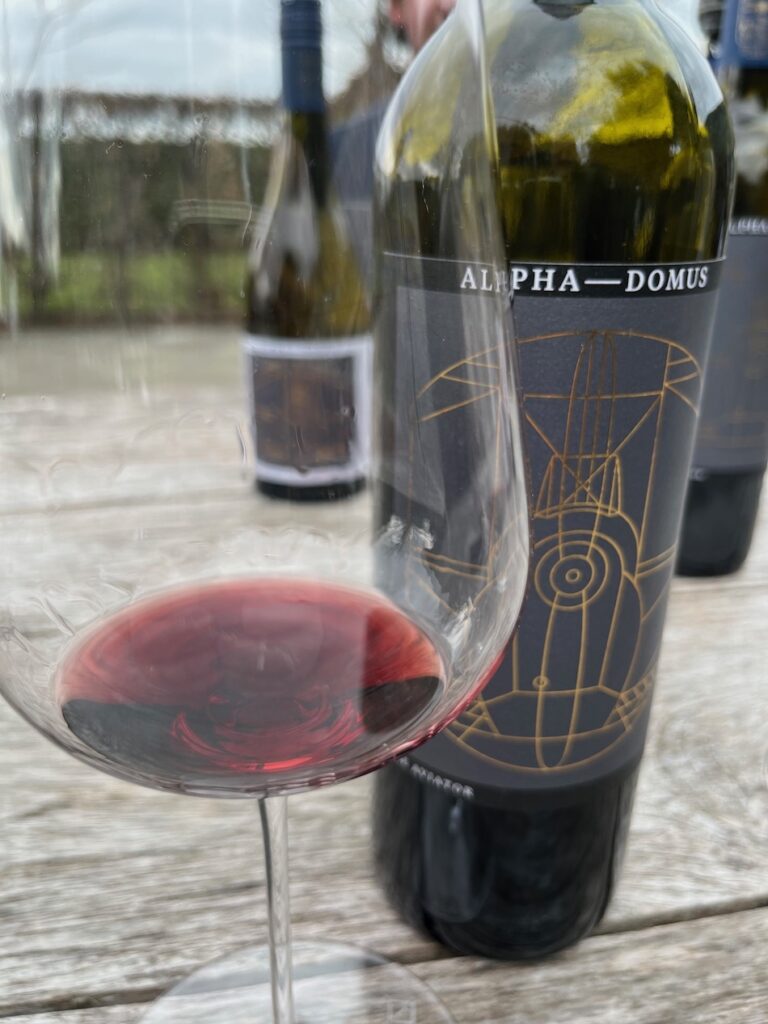
Here are two vintages of Aviator, which is our flagship wine. We don’t make it every year. We just make it in the years that the Cabernet is perfect. We do spend a certain amount of money on corks. These are a local Hawke’s Bay supplier – AWI. Alberica is Portuguese – a fifth generation cork industry guy. Part of his QC program he sniffs about 3000 corks a day.
He’s like a machine. He puts three corks in a jar with a micro amount of water, because you need moisture to be able to smell the cork taint. Closes them and puts them on the shelf overnight and sniffs them the next morning. If you spend a little bit extra, you can get the ones he’s pre-sniffed! We use corks because the people who buy this wine want corks. So we let them have what they want.
The 2015 was my first vintage, so I do have a soft spot for it. But it is Cabernet at its floral best. Not the heaviest Cabernet in the world – and a blend obviously. Everything we can to make it better. It looks like Bridge Pa – not a big, heavy, broad, South Australian Cabernet. They are made from select rows in the vineyard, and it is usually just one bunch per shoot. It gets a hand leaf-pluck as well. We double net them – so side nets as well as top nets!
WF: I like the way that the 2019 really ‘sits up’ and then seduces you with the tannin afterwards. Maybe the future is Cabernet (laughs)! I loved the Syrah but this is quite special.

